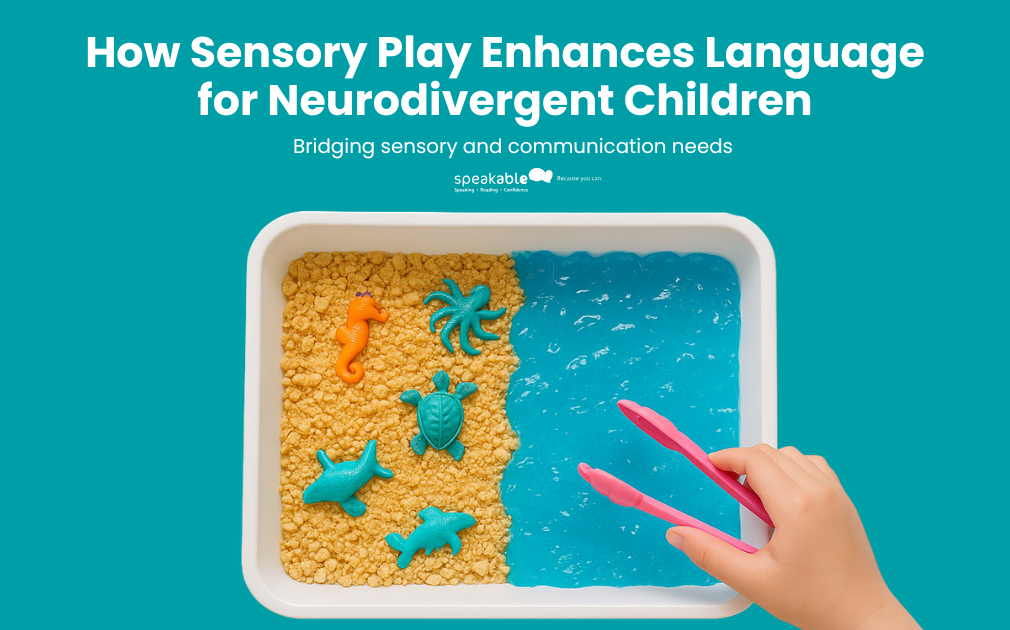How Sensory Play Enhances Language for Neurodivergent Children
Bridging sensory and communication needs
For many neurodivergent children, the path to communication is as unique as they are. Speech and language development doesn’t happen in isolation — it’s deeply connected to how children process and respond to sensory input. Sensory play creates a bridge between sensory needs and communication growth, offering a safe, engaging space for language to flourish.
Why sensory play matters for communication
Sensory play engages the senses — sight, sound, touch, taste, and smell — and can also involve movement and balance. For children with autism, ADHD, or sensory processing differences, this type of play helps regulate their nervous system and improves focus, making it easier to engage in communication. When children feel safe and regulated, they are more open to listening, observing, and responding.
How sensory play builds language skills
- Encourages shared attention: Activities like pouring rice between containers or watching bubbles float create shared moments of focus, a key foundation for conversation.
- Expands vocabulary: Talking about textures, colours, sounds, and actions during play introduces new words in a meaningful way.
- Supports turn-taking: Games like passing a ball or taking turns with a sensory bin encourage the back-and-forth rhythm of conversation.
- Provides a safe channel for expression: Sensory play reduces performance pressure, allowing children to communicate more naturally.
Examples of Sensory Play for Language Development
You don’t need expensive equipment with a little creativity, everyday items can become powerful language-learning tools. Here are some ideas to inspire you, each linked to a video so you can see them in action.
Ocean Sensory Bin
You can turn simple ingredients into a mini beach scene — think blue jelly for water, crushed cereal for sand, and little sea creatures for a touch of adventure. Add scoops, tongs, and cups so children can explore textures, practise new words, and even enjoy a safe taste experience.
Mix-and-Match Sensory Bins
With a few household items, you can create endless sensory experiences. Popcorn kernels, shaving cream, coloured rice, or even “mud” made from cocoa and cornstarch — each one invites different words, actions, and stories. Rotate the contents to keep it exciting and build new vocabulary every time.
Cooking-Inspired Sensory Play
Dry pasta, cereal, water, spoons, and silicone moulds can be all you need for hours of pretend cooking fun. Children can stir, scoop, pour, and “serve” their creations while learning action words and exploring textures. This type of play combines sensory regulation, fine motor skills, and language learning in one tasty package.
Tips to make sensory play language-rich
- Follow the child’s lead to keep engagement high.
- Model language with short, clear sentences and repeat key words.
- Pause for response so the child has extra processing time.
- Pair words with actions for stronger understanding.
Creating a supportive environment
For some neurodivergent children, certain textures, sounds, or smells can be overwhelming. Observe their reactions and adjust activities as needed. A calm and predictable environment allows for exploration without overstimulation, making it easier to connect and communicate.
How Speakable can help
At Speakable, we know that communication is more than words — it’s connection. Our speech pathologists incorporate sensory-based strategies into therapy to support both language development and sensory regulation. We work alongside families to create practical, engaging activities tailored to each child’s needs.
Want to learn more about integrating sensory play into your child’s language journey? Contact us to discover how we can help.




